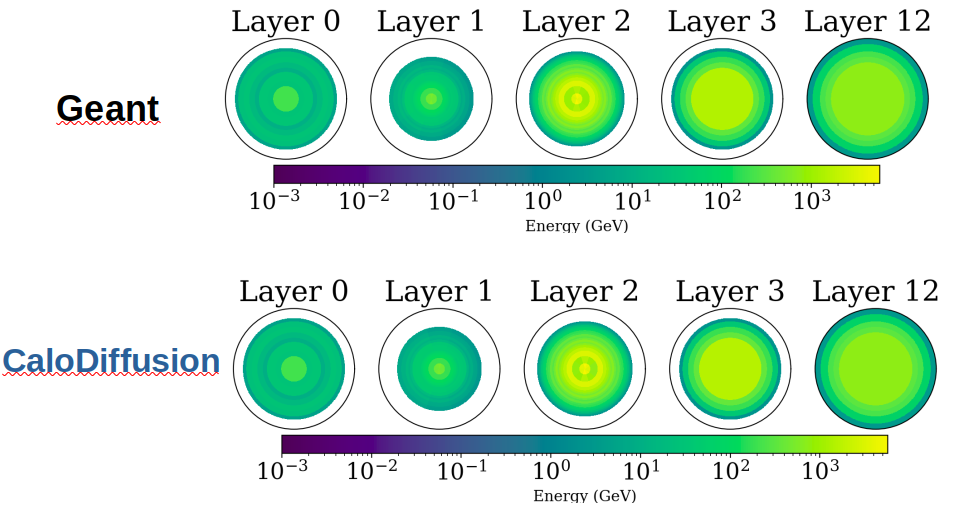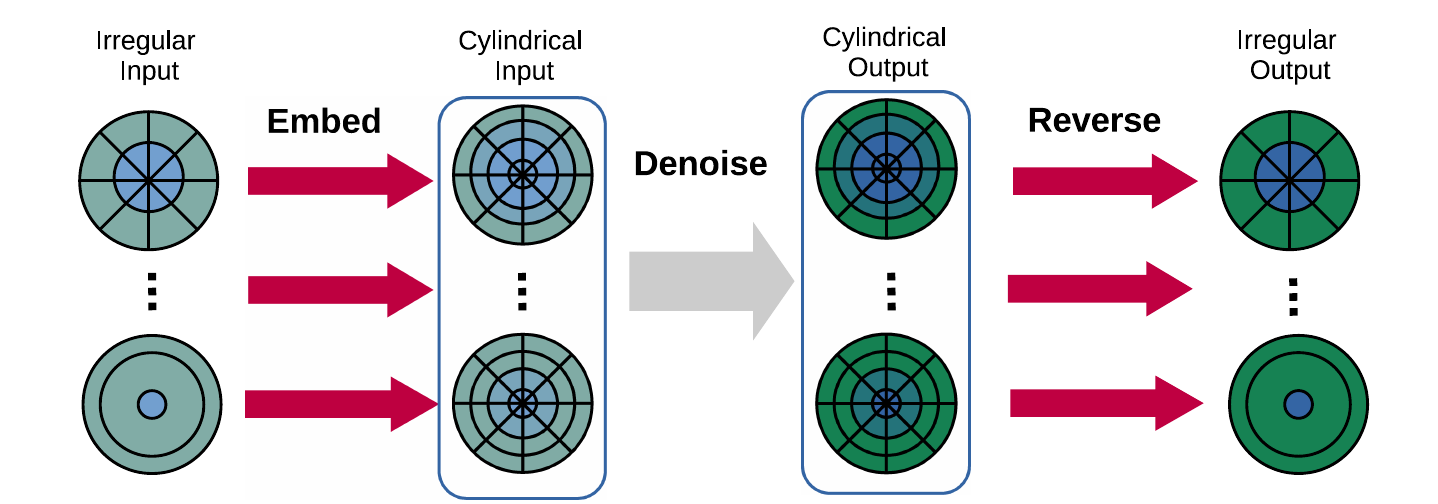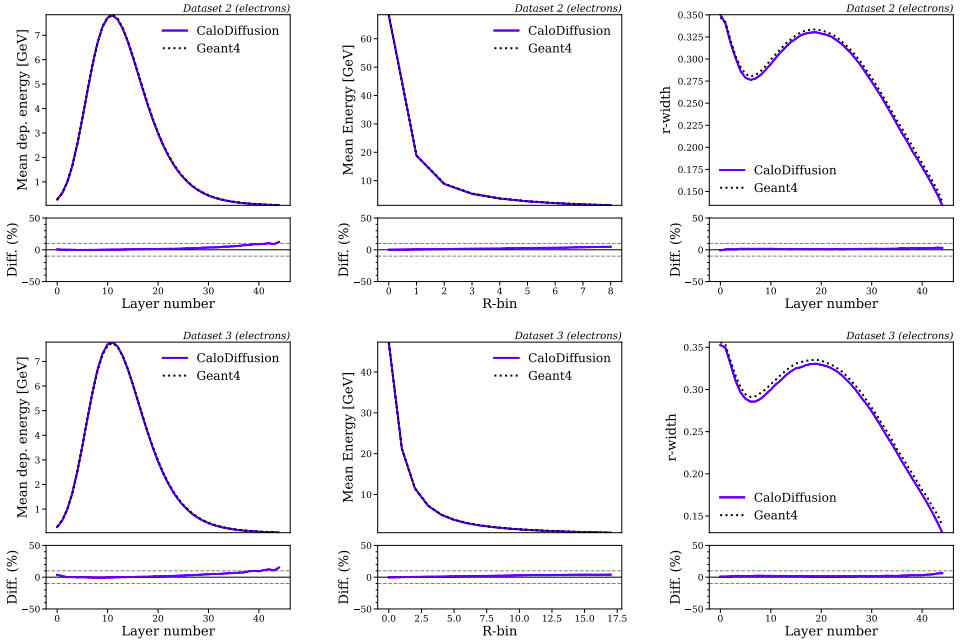CaloDiffusion
Diffusion models for LHC calorimeter simulations
Simulations play a crucial role in making sense of the massive amounts of data produced by the LHC. When sifting through the extremely complex data produced by our detectors, we need a handle on what were are looking at. Being able to simulate what the collisions of known processes would like in our detector, and what the signatures of hypothetical new particles would leave is essential.
One crucial aspects of these simulations is the detector response, We need to know what sort of signals we would see in our detector if a particle of a given type and energy were passing through. Fortunately we have a very accurate first-principles understanding of how particles interact with the materials of our detector, available in a public software package GEANT. However, these simulations can be quite computationally expensive to perform, particularly for the ‘calorimeter’ portion of the detector. In calorimeters, a single high energy particle will interact with the particles present in the material to produce a ‘shower’ of secondary particles (each of which can further produce additional showers, etc), which must be accurately simulated to get a realistic estimate of the detector signal. As we move towards higher data volumes in the High-Luminosity era of the LHC, and develop even more complex calorimeters (like the CMS HGCAL), we will no longer have the computing resources to perform these detailed calorimeter simulations. This would significantly hurt the precision of our data analysis techniques unless a solution can be found.
Thats where generative machine learning may come to the rescue. If we can train a machine learning model that can accurately generate these calorimeter showers faster than GEANT, then it could be used GEANT’s place in the simulation workflow. People in the HEP+ML community have been working on this problem for a few years and a variety of approaches are being explored. Our approach, CaloDiffusion, is based on a type of generative machine learning model called ‘diffusion’, which has extemely popular starting in ~2022. It is the backbone behind most of the popular AI image generation technologies: DALLE, MidJourny, StableDiffusion, etc. Using CaloDiffusion, we are able to obtain showers that are nearly indistiguishable from Geant.

Diffusion works as a noising/denoising process. One starts with a normal image you can define a noising process that gradually adds noise to it across many steps (around 100 steps is typical), until the image is essentially pure noise. The machine learning model is then trained to reverse this process; by learning how to remove the noise you have added at each step. Once trained, this model can then generate new images by starting with a pure noise image and iteratively applying its denoising step. Additional ‘conditioning’ information about the target image can also be given to the model, during training to help with the denoising and to allow one to guide the type of image that is generated once trained. This is particularly important for our use case, since we don’t want to generate a random particle shower, but a shower that corresponds to the specific particle type and energy that we want to simulate.

Calorimeter data isn’t exactly like images but they have some simularities. Energy is deposited into different sensors across several layers of material. The full shower is then similar to a 3D image, where each ‘voxel encodes the energy in a given cell. Unlike objets in images which have an x and y translation symmetry, showers typically have cylindrical symmetry when centered on the point of impact of the initial particle.
For these reasons, in CaloDiffusion we replaced the use of regular convolutions used in standard image processesing models with 3D, cylindrical convolutions, which better encode the symmetries of our data. We also included a new method to allow these convolutions to be conditional on the shower layer and radial position, which allows more expressive freedom to the model without any additional parameters.
Unfortunately, realistic detectors never have perfect cylindrical structure. Different layers are often made of different materials, have different sensor sizes and layouts. This makes the inherent data structure of these shows very irregular, which is difficult to deal with for machine learnin models. To handle this difficulty while retaing the geometric power of convolutions, we developed a new embedding approach called GLaM which performs a lightweight mapping from the irregular geoemtry to a regular cylindrical shape, which can then be processed with our cylindrical convolutions. This embedding is learned simulataneously with the denoising model.

We applied our approach to three different datasets, representing three different detectors, that were part of the community Fast Calorimeter Simulation Challenge. The first dataset is based on part of the ATLAS detector and includes both photon and pion showers. Because it is based on the real ATLAS detector it has realistic irregularities between the different layers, which we handle with our GLaM approach. The total dimensionality of these showers is ~500 voxels. The second and third datasets are based on an idealized perfectly cylindrical detector, but feature much high dimensionality (6480 and 40,000 voxels respectively).
We then compared the showers generated by CaloDiffusion and Geant across many different features and found CaloDiffusion was able to match Geant extremely well across nearly all of them.

We also perfomed quantitative comparisons between the two sets of showers. One popular metric is to train a NN classifier to attempt to distinguish between the two sets of showers. If this classifier is unable to perform well (AUC $\to$ 0.5), this indicates the two samples of showers are nearly indistinguishable. We found classifier AUC’s of 0.55–0.65 on the different datasets, the best values reported to date. Our approach particularly shined on the highest dimensional dataset, in which we significantly outperformed previous approaches.
Further comparisons between CaloDiffusion and other approaches are being perfomed as part of the CaloChallenge, but the results so far show CaloDiffusion produces the highest quality showers for all datasets (with ~40 total submissions).
Further improvements to CaloDiffusion are in progress, and we hope to apply the model to simulate the CMS HGCAL in the near future!